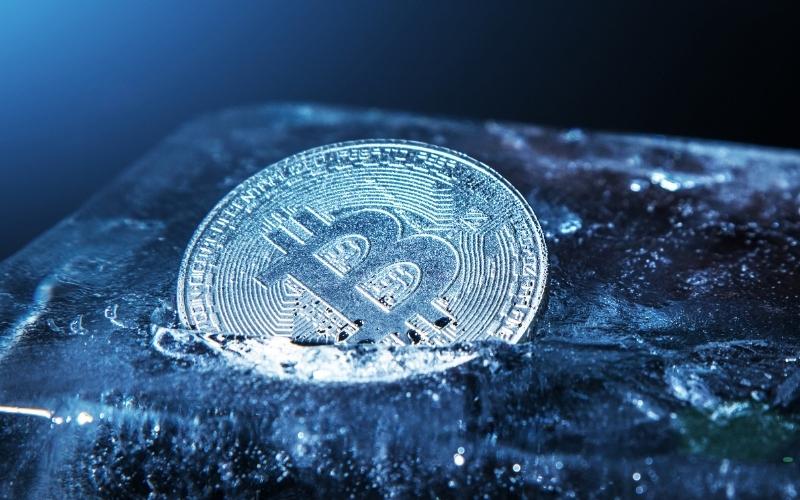Trading any financial asset has its fair share of risk, and cryptocurrencies are no different. In fact, these crypto-assets arguably carry the largest amount of risk, owing to their through the roof volatility levels. The year 2021 has seen Bitcoin, the leading crypto coin in market cap, fluctuate greatly to hit new highs and new lows all in a span of a few months. The NFT and metaverse waves has also seen similar fluctuations throughout the year, as have most other cryptocurrencies.
What is crypto winter?
Crypto winter is a phenomenon that describes a terrible time for crypto enthusiasts when the prices of Bitcoin and other cryptos get stuck at low levels after a sustained bearish trend. Usually, prices may be stuck here for prolonged periods.
Such a situation manifested in 2018 when the price of BTC fell more than 65% in the first two months of the year. After starting the year at the north of $16,000, the price had fallen to almost $8,000 by the first week of February. The rest of the year saw Bitcoin’s price struggle with intermittent price drops. By year’s end, the coin was trading at a lowly $4,000. What’s more, even the market cap of Bitcoin fell below $100 billion, a feat that had not been achieved since October 2017.
What caused this tumble from highs of nearly $20,000 the year before to $4,000? Well, it was a bunch of dominos that culminated in this crypto winter. First, the adoption of Bitcoin at the time was mostly driven by emotion and FOMO. It had all the makings of a bubble. Not many people who invested in the coin understood its implications and inner workings. All they wanted was the free money it promised in profits. Therefore, when it began to plummet, the majority of investors just sold off their holdings, leading to further crashes.
Second, there were numerous significant hacks on crypto exchanges that slowly diminished investor confidence. Tokyo-based Mt. Gox, having once been the most popular crypto exchange platform, was hacked in 2014 to the tune of $473 million. In 2016, DAO, a blockchain organization based on Ethereum, lost $50 million to hackers. At the beginning of January 2018, Coincheck, a Japan-based exchange, was hacked for $534 million. This was the final nail in the coffin, which led to the year-long winter.
Factors pointing to a possible incoming crypto winter
Since 2018, Bitcoin, along with many other altcoins, staged an impressive recovery to hit new all-time highs. However, analysts believe we may be looking at another crypto winter in the near future. Let’s look at some of the warning signs they have labeled red flags.
China’s ban on cryptocurrencies
In September 2021, the People’s Bank of China declared all cryptocurrency-related business illegal and criminalized all transactions involving crypto in the country. According to officials, the ban was because cryptocurrencies have disrupted China’s traditional financial systems and facilitated financial crimes such as money laundering.
Statistics show that China was the world’s leading country in Bitcoin mining and supported the largest volume of crypto transactions. Following this ban, exchanges are now being penalized for doing business with anyone inside China’s borders. Chinese miners opted to relocate to neighboring Asian countries such as Singapore and Kazakhstan.
Kazakhstan’s power rationing
After the ban on crypto mining operations in China, a sizable proportion of miners relocated to Kazakhstan. Now, Kazakhstan is a resource-rich country with sizable deposits of oil, natural gas, uranium, and coal. Traditionally, it has been known to export energy, seeing as it produces more than its total demand.
However, when the Chinese miners entered the country, this surplus quickly disappeared due to the miners’ large energy demands. Their demand was so high that in July, there was a total blackout in Kazakhstan’s largest city, Almaty. These power shortages are only expected to increase come winter when the country’s power demands spike.
To curb the shortage, Kazakhstan’s national grid operator KEGOC started cutting off the power supply to some miners in the country. In October, the Energy Ministry introduced a bill to limit the power supply to new mines at 1MW per mine and 100MW for the whole country. This will see mining operations significantly decrease when the bill comes into effect.
Mt. Gox settlements
2014 saw the popular crypto exchange platform get hacked, where investors lost more than $400 million. At the time, Bitcoin was trading at $500 a pop. The investors who lost their funds took to the court in January 2021, seeking reimbursement for their losses. They won the case in November, and the court ruled that a total of 141,686 Bitcoin be released to the victims of the attack.
At the time of the ruling, BTC was trading at $67,000. This means Mt. Gox is set to compensate over $8.5 billion in BTC to the victims of the attack. Most analysts predict this payoff will happen in the first or second quarter of 2022. Following the dump of nearly 150,000 BTC to the market, the price of the coin will likely plummet 80 – 90%, according to crypto analysts. In fact, after the ruling, Bitcoin’s price fell to $58,600 but soon recovered to retrace the $60,000 psychological level. At the time of writing, the coin is trading at $48,800, so maybe the crypto winter is sooner than we think.
Conclusion
Crypto winter refers to a phenomenon where the price of Bitcoin and other crypto-assets gets stuck at low levels for a prolonged period of time. It usually happens at the end of a sustained downtrend. The last crypto winter happened in 2018 when prices remained low for the better part of a year. Today, there are several signs pointing to an impending crypto winter. These include the Chinese ban on crypto mining and trade, the rationing of power to mines in Kazakhstan, and the court-mandated compensation of Mt. Gox hack victims.



